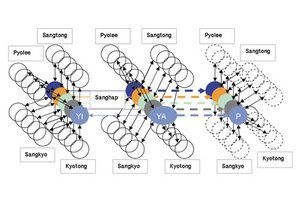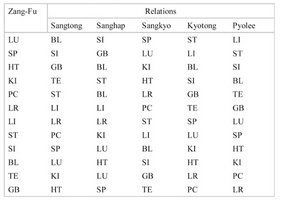Whether you accept it, avoid it or live somewhere in between, insurance coverage has become a defining issue for our profession. Patients increasingly expect to use their benefits, practitioners want to be compensated fairly for their time and expertise, and the system itself remains – at best – fragmented. The encouraging news is that coverage has expanded in meaningful ways. The challenging news is that reimbursement, across the board, remains inadequate.
A Study of Relationships
Sa-Ahm's five element acupuncture method is known to be one of the most effective acupuncture techniques in Korea because it gives an instant response at the time of treatment and has a high success rate in resolving chronic problems.1,2 This advantage gives patients confidence and lends credibility to the treatment. In this article, relationships among the Zang-Fu of Sa-Ahm's five element acupuncture are interpreted. This approach is helpful in understanding the Sa-Ahm's five element acupuncture because general traditional Chinese medicine explains just Pyolee (externally-internally related). A proper understanding of the Sa-Ahm's five element acupuncture is achieved by understanding various relationship of Zang-Fu.
Theory
The five Shu points are changed according to the five-element process and create five new movements.3 Metaphorically, those five movements are classified as Wood, Fire, Earth, Metal, and Water. Furthermore, both yin and yang have movements of the five elements, which are called the five factors. These five factors are physiologically applied to the Zang-Fu and can then be expressed as the metaphorical terms Jing (well), Ying (spring), Shu (stream), Jing (river), and He (sea). For example, the Jing (well) point of yin is wood, and the Jing (well) point of yang is metal. The phase of metal is produced when the Jing (well) point of yin and the Jing (well) point of yang interact together, and this process explains how yin and yang interact with each other within the five elements to produce the five Shu points. In addition, the interactions create the phases, which are metaphorically applied to the physiology of the human body.
Relationships between Yin Yang, five elements' movement, six Qi, and five Shu points. P = phase, YA = Yang, YI = Yin.

Figure 1 shows the relationship between yin and yang. Yin and yang promote each other and they maintain diverse relationships with six qi surrounding them, making new relationships. As a result, yin and yang can be differentiated into Zang-Fu, and the physiology of the differentiation produces the phase. A disorder of the phase indicates a physiological disorder and any pathology can be classified into five categories. Thus, a diagnosis and a differentiation can be made by examining the Zang-Fu falling under the category of pathology. At this point, clearly, a comprehension of Sa-Ahm's acupuncture can only be achieved with a good understanding of yin-yang and five elements and their metaphorical aspect over a broad range of clinical practice. Yin and yang blend with each other even though they are not stable; rather, they are energy in constant motion and change. Thus, a principle is needed to classify relative characteristics between yin-yang and the five elements, and a constant balance and harmony in exchange and circulation between yin and yang is maintained. In conclusion, the entire concept involves terms that describe the relationship of Zang and Fu in the five elements.
The relation of sanghap is produced when yang restrains yin in the Zang-Fu in the theory of the five elements, which creates a new phase. The same affiliated group of Zang-Fu is referred to as sangkyo, which has the same qi. The relation of Pyolee (externally-internally related) is a state that is affiliated with the same elements linked to each other between Zang and Fu internally and externally. Opposing six qi which appears in the hands and feet is defined as kyotong, and the relationship between traffic, according to the intensity of the opposing six qi, is defined as sangtong. Therefore, five different interrelationships exist, as indicated in Table 1.
Table 1. Five relationships between Zang-Fu:

BL = bladder; GB = gall bladder; HT = heart; KI = kidney; LI = large intestine; LR = liver; LU = lung; PC = pericardium; SI = small intestine; SP = spleen; ST = stomach; TE = triple energizer.
Six qi exist in the macrocosm, and six qi also exist in the microcosm; these create six physiological mechanisms in the human body: Tae yin, Shao yin, Jue yin, Yang ming, Tai yang, and Shao yang.
Yin-yang moves within the five elements and produces a new phase. Phases themselves move within yin-yang and are influenced by the six qi. Furthermore, the six qi undergo constant change. Five categories can be used to classify the relationships between the five elements and the six qi. Metaphorically speaking, a human body is a microcosm, and six qi exist in it. The etiology and the pathogenesis of a disorder can also be differentiated based on this concept. In the entire process, five phases are produced and transform to create five Shu points. The fundamental relationship between yin and yang is that yang restrains yin. In this process, phases move into yin-yang, and each phase forms five different relationships.
Clinically, understanding the theory of yin and yang is essential to approach the Sa-Ahm Five Element Acupuncture and it is very important to get the main concept of the relationships among the Zang Fu. Therefore, understanding the various relationships among the Zang- Fu, which is Sanghap, Sangkyo, Pyolee, Kyotong, Sangtong, is the key of knowledge for Sa-Ahm Five Element Acupuncture and it could be the practical indicator for the clinic field.
References:
- Lee, K.L. and Bae, S.K. Korean acupuncture medicine. Komunsa, Busan; 1991: 215–242.
- Hicks, A., Hicks, J., and Mole, P. Five element constitutional acupuncture. Churchill Livingstone,Edinburgh; 2005 (383−384).
- Maciocia, G. The foundation of Chinese medicine. Churchill Livingstone, Edinburgh; 2005: 783–855.



